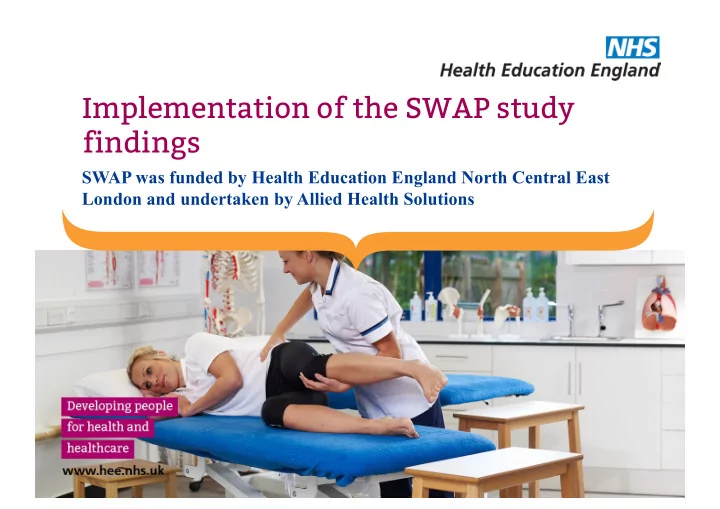

Implementation of the SWAP study findings SWAP was funded by Health Education England North Central East London and undertaken by Allied Health Solutions
Purpose of this presentation This slide deck has been produced for AHP managers and AHP team leaders employed in North Central East London. The hope is that this set of slides will be a useful tool to help this group of staff explain SWAP and progress the implementation of the findings from this work.
Context, Scope and aim of SWAP Context – Health Education England North Central East London funded this study in response to the growing awareness of the importance of the support workforce in delivering healthcare, and the potential they have to significantly enhance the patient experience. Scope – The scope of the study was restricted to three Community Education Provider Network (CEPN) footprints: Barnet, Tower Hamlets, Barking and Dagenham, Havering and Redbridge. Aim – To gain a greater insight into how allied health services in North Central East London employ and deploy Allied Health Support Workers (AHSWs).
Strands of activity I. Raising the awareness of the local Allied Health Professionals (AHPs) with regards to current support worker policy landscape. II. Mapping of the current support worker roles in services delivered by AHPs. III. Identification of potential new roles for support workers and apprenticeships in these services. I. Collating information about the current education, training and development opportunities for this workforce.
Why this work and why now? • Francis Inquiry (2013) • Cavendish Review (2013) • HEE Talent for Care (2014) • Nursing Associates (2016) • Apprenticeships (2016) ‘While the support workforce make up 40% of the total NHS workforce and provide around 60% of patient care, this group receives less than 5% of the national training budget’ (HEE’s Talent for Care Framework).
What SWAP has found • Many of the support workers who engaged in this study really enjoy the work that they do and value the education opportunities they have had, in particular the Trusted Assessor Training. • AHPs who work with this group freely admit that they do not really appreciate the support workers’ current contribution to, or their potential to further enhance, the patient journey.
Recommendations from SWAP The study team made six recommendations (A-F) based on the SWAP findings.
Recommendation A Trust education and training departments should work closely with HEE to standardise an approach to developing this workforce. Background to recommendation A Beyond the statutory and mandatory training there is little standardised education and training for the allied health support workers. Recommendations from SWAP
Recommendation B Background to recommendation B Trust education and training departments The new mandatory Care should ensure all their Certificate has been allied health support specifically developed with workers have the the healthcare assistant in opportunity to achieve mind and SWAP has the Care Certificate and highlighted that it has that the learning limited direct clinical outcomes are of direct relevance for the allied clinical benefit to this health support workforce. workforce and the service they provide. Recommendations from SWAP
Recommendation C Human resources and operational development departments should review their approach to deploying allied health support workers and aim Background to for parity of activity. recommendation C There is considerable variation in the way that allied health support workers are deployed, even within an organisation. Some are undertaking tasks that stretch or even exceed the limit of the employment Band. Recommendations from SWAP
Recommendation D Background to recommendation D Organisations and departments review the The allied health support environment in which the workers reported: allied health support 1. They feel isolated workers are employed. With 2. They are undervalued the aim of enabling them to 3. They are under- network together both represented within and outside of the 4. The true contribution organisation; to enable their they make to the service profile to be raised; to is not fully appreciated ensure that the contribution they make to patient care is evidenced. Recommendations from SWAP
Recommendation E Organisations should adopt a more consistent approach to naming this workforce. Background to recommendation E There is an inconsistent approach to naming this workforce. This situation should be addressed for the benefit of the patients, the support workers and their colleagues. Recommendations from SWAP
Recommendation F Background to recommendation F Allied Health professional Bodies should consider Disappointingly SWAP reviewing their approach found that very few of the to support the allied allied health support health support workers. workers belong to a professional body or are aware of the support that the allied health professional bodies can offer them. Recommendations from SWAP
Next steps: Implementation of the SWAP findings Teams are encouraged to consider how they will implement these SWAP recommendations The following stages might be one way of exploring how teams can effectively use the SWAP study outcomes: • Reflection • Discussion • Actions
Implementation of SWAP findings Stages I & II Stage I Reflection • What stood out, from the SWAP findings, for you and your team? • Are there areas that surprised you? Why do you think this is the case? Stage II Discussion • As an individual and colleague what can you do in response to the SWAP recommendations? • What areas can the team explore to adopt these recommendations? • What do you think your organisation can and/or should do to address these recommendations? • How might your team influence your organisation to implement the SWAP findings?
Implementation of SWAP findings stage III Stage III Actions Teams might like to consider the following approach to implementing the SWAP recommendations: 1. Include support worker issues as a standing item on team meeting agendas. 2. Ensure support workers are represented at team meetings 3. Ensure full and frank discussions about support workers take place in the team and department. 4. Consider who in your organisation should receive a copy of the report and recommendations and how it is followed through to influence institutional strategic workforce development.
Recommend
More recommend